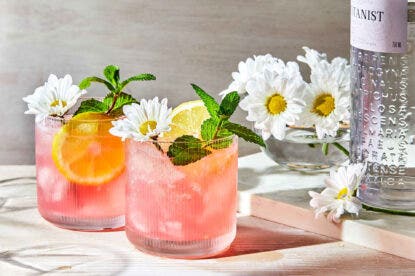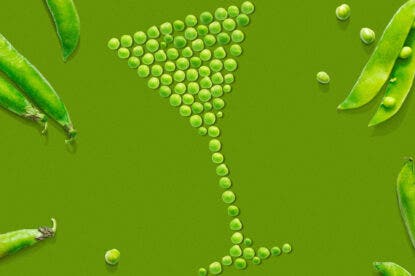Madeira, the subtropical Portuguese island off the coast of northwest Africa, is best known for its eponymous fortified wine. But walk into any taberna on the volcanic locale and you’re far more likely to see locals drinking squat glasses of golden poncha. The sweet, citrusy mix of rum, fruit and honey or sugar is essentially the signature cocktail of “the Pearl of the Atlantic.”
The traditional beverage has deep cultural significance and has long been considered a remedy to all kinds of ailments. “Poncha is our medicine,” says Sofia Maul of Wine Tours Madeira. “If you’re with friends and someone says, they have a runny nose, a sore throat or a broken heart, someone is going to turn around and say, ‘What you need is a poncha.’”
Maritime Beginnings
The exact origins of poncha are vague, but everyone seems to agree the drink was borne of Madeira’s maritime heritage. One theory is that the tincture was developed to prevent scurvy, a disease caused by a lack of vitamin C that killed more than two million sailors between the time of Columbus’s transatlantic voyage and the mid-19th century.
You May Also Like: Tasting a Madeira that Stood the Test of Time
“Sailors wanted to take lemons and oranges onboard the ships,” says Maul. To ensure the citrus fruits would last throughout the long voyages, they would use rum to preserve them, explains Maul: “To make it drinkable, they would add either sugar or honey—and like that, you get our traditional poncha.”
Other locals claim that the beverage was created as a sleeping potion for fishermen trying to snooze onboard their vessels. “I guess it would help them rest because it is very strong,” says Madeira tour guide Mary Anne de Freitas. “It goes down smoothly—you don’t feel it until a little later on.”
Proper Equipment
Many still accidentally overindulge in the refreshing drink. Part of the problem is the small glasses in which it’s served, says Maul. “It is pretty strong stuff. So, it’s not to be gulped down… it’s sipped on.”
It also has a deceivingly light and airy texture. The drink is customarily made fresh, right in front of guests, with a special wooden muddler and mixer that’s used to crush the ingredients together and aerate the liquid until frothy and creamy. “Poncha, if it’s done right, has a creamy texture,” says Maul. “That comes from mixing it with this instrument.”
You May Also Like: How Madeira Transformed from an Average Table Wine to a Fortified Powerhouse
The instrument, called a caralhinho, similarly gets its name from the island’s seafaring traditions. When flipped upside down, it resembles a crow’s nest, the basket-like lookout high up on the mast—widely considered the worst place to be on a ship—where badly behaved sailors would be sent as a form of punishment. Because it’s so far from the ship’s center of mass, all of the rotational movement of the vessel is amplified, often leading to intense seasickness even in seasoned sailors. Over time, the word “caralho” became a swear word, as well as a name for male genitals. “’Caralhinho’ basically means ‘little dick,’” says Maul.
Poncha à Pescador (Fisherman’s Poncha) Recipe
Adapted from Tomé Mendes, co-owner of Jaca Hostel in Porto da Cruz. Serves 2.
Ingredients
Peel two lemons, avoiding as much of the bitter white peel as possible, and place in a large jar with the sugar and a splash of rum. Crush the mixture into a rough paste with a caralhinho or pestle.
Add the remaining rum, stir to combine and pour in the lemon juice.
Mix for five minutes. Taste for sweetness, and add more sugar as needed. Strain and serve.
FAQ
Where Can You Try Poncha?
You can find poncha in bars all over the island, including many small and unassuming spots. “My favorite one in [the capital city of] Funchal is a little grocery shop next to the market, called A Mercadora,” Freitas says, noting there’s a little bar in the back. She also recommends exploring the fishing village of Câmara de Lobos. “There is a little bar called Filhos do Mar where they have the Vasco da Gama Poncha, which has secret ingredients,” she says. Also great is
She also suggests visiting the valley of Serra de Água in the center of the island to find traditional poncha tabernas. “The most famous one in Serra de Água is Taberna da Poncha,” Freitas says.
Are There Variations of Poncha?
“We make poncha with [non-native] fruits as well, like passionfruit, tangerine, Surinam cherry, tamarillo—very exotic ponchas,” says Maul. In the past, she explains, ships would stop by the island on their way back to Europe from destinations in Asia and South America. They would leave behind seeds and cuttings taken from their travels. Thanks to a subtropical climate, many of these plants took root on the island, adding to the array of possible poncha ingredients.
“But the fundamentalists will say that those aren’t real ponchas—that those are cocktails.” The above recipe would appease those purists.
From the Shop:
Published: March 21, 2024
















